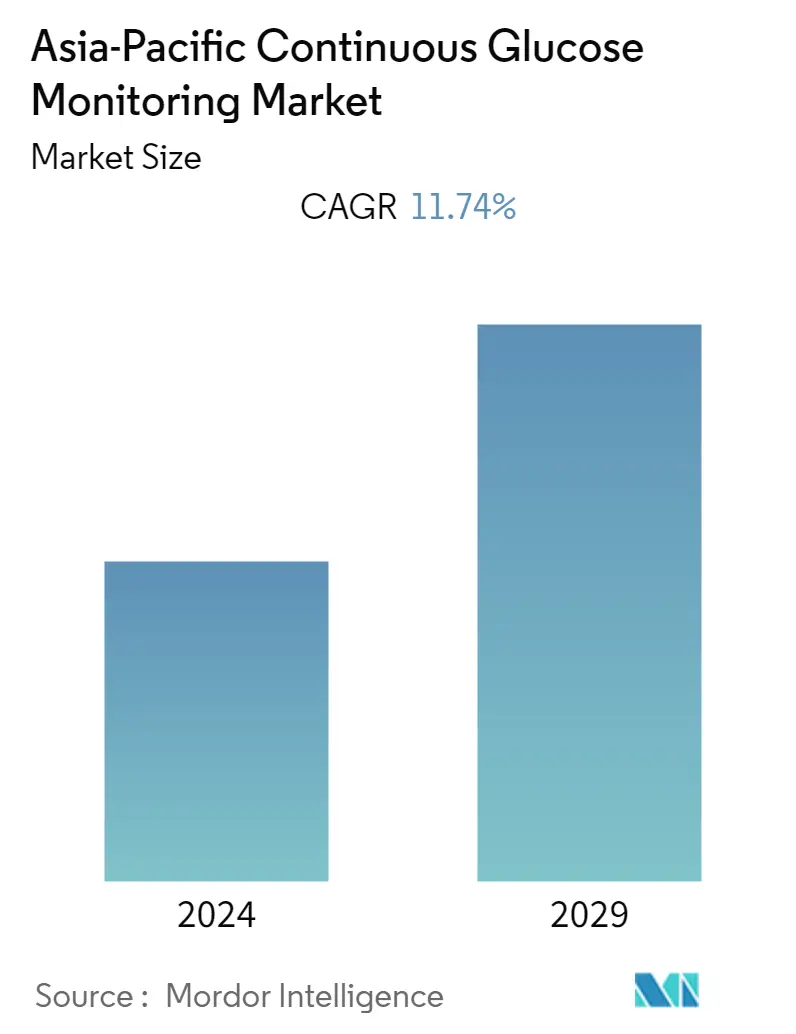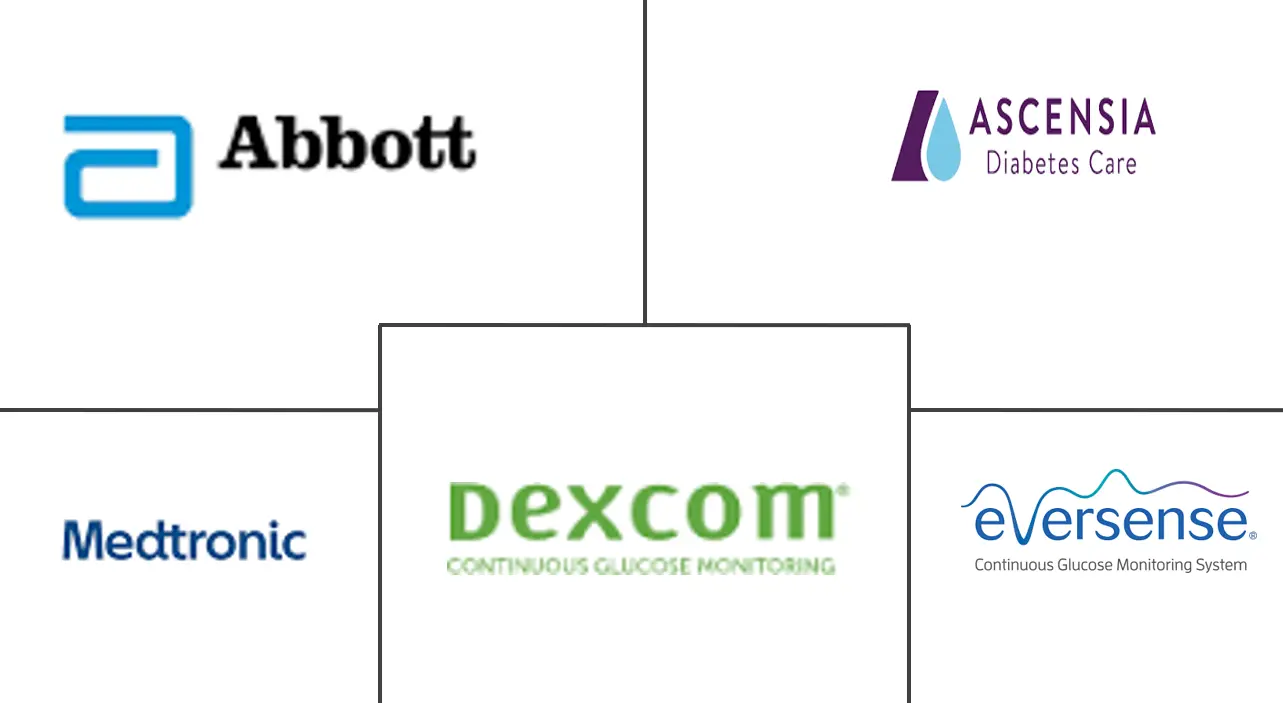Market Size of Asia-Pacific Continuous Glucose Monitoring Industry

| Study Period | 2019 - 2029 |
| Base Year For Estimation | 2023 |
| Forecast Data Period | 2024 - 2029 |
| Historical Data Period | 2019 - 2022 |
| CAGR | 11.74 % |
Major Players
*Disclaimer: Major Players sorted in no particular order |
Asia Pacific Continuous Glucose Monitoring (CGM) Market Analysis
The Asia-Pacific Continuous Glucose Monitoring Market size is estimated at USD 1.06 billion in the current year and is expected to reach USD 2.01 billion by the forecast year, growing at a CAGR of 11.74% during the forecast period.
The COVID-19 pandemic positively impacted the Asia-Pacific Diabetes Care Devices Market growth. Patients with diabetes, infected with COVID-19 may experience elevated blood glucose, abnormal glucose variability, and diabetic complications. The prevalence of diabetes in people with COVID-19 caused a significant increase in severity and mortality of COVID-19 in people with either type 1 (T1DM) or type 2 diabetes mellitus (T2DM), especially in association with poor glycemic control. While new-onset hyperglycemia and new-onset diabetes (both T1DM and T2DM) have been increasingly recognized in the context of COVID-19 and have been associated with worse outcomes. To avoid aggravation, a patient's blood glucose should be monitored regularly, which has underlined the importance of blood glucose monitoring devices. The pandemic emergency has created a rise in remote care from both patients and providers and removed many long-standing regulatory barriers.
According to International Diabetes Federation (IDF), 90 million adults (20-79) are living with diabetes in the IDF South-East Asia (SEA) Region in 2021. This figure is estimated to increase to 152 million by 2045 and 206 million adults (20-79) are living with diabetes in the IDF Western Pacific Region in 2021 which is estimated to increase to 260 million by 2045. The main diagnosis for diabetes patients is imbalances in blood glucose levels, which are not in compliance with the standard blood glucose levels. The general lab diagnostic tests can only help to diagnose the disease by physicians. Patients with more fluctuations in glucose levels need to get it checked every day. Patients administering insulin need to check their blood glucose levels frequently, adjust the doses of insulin, or change the medication, if necessary.
The incidence of newly diagnosed cases of Type 1 and Type 2 diabetes is observed to be on the rise, primarily attributed to factors such as obesity, unhealthy dietary habits, and lack of physical activity. The escalating frequency and pervasiveness of diabetic patients and healthcare expenses in developed nations are indicative of the growing utilization of diabetic care products. Furthermore, the mounting adoption of insulin delivery devices and the surging prevalence of diabetes are propelling the expansion of the market. Prominent manufacturers are directing their efforts towards technological advancements and the creation of sophisticated products to secure a significant market share.
Asia Pacific Continuous Glucose Monitoring (CGM) Industry Segmentation
Blood sugar levels are automatically monitored by continuous glucose monitoring both throughout the day and at night. Patients with diabetes can quickly and easily see their glucose level anytime. Patients can also review the glucose fluctuations over a few hours or days to spot trends. Real-time glucose monitoring enables patients to manage their diet, physical activity, and medications more intelligently throughout the day. The Asia Pacific Continuous Glucose Monitoring Market is segmented by Component (Sensors and Durables) and Geography. The report offers the value (in USD) and volume (in Units) for the above segments. We will provide a segment-wise breakdown (Value and Volume) for all the countries covered under the Table of Contents.
| Component | |
| Sensors | |
| Durables |
| Geography | |
| Australia | |
| China | |
| India | |
| Indonesia | |
| Japan | |
| Malaysia | |
| Philippines | |
| South Korea | |
| Thailand | |
| Vietnam | |
| Rest of Asia-Pacific |
Asia-Pacific Continuous Glucose Monitoring Market Size Summary
The Asia-Pacific Continuous Glucose Monitoring Systems market is poised for significant growth, driven by the increasing prevalence of diabetes and the rising demand for advanced diabetes care solutions. The market is experiencing a surge in adoption due to the growing incidence of Type 1 and Type 2 diabetes, largely attributed to lifestyle factors such as obesity and unhealthy dietary habits. The COVID-19 pandemic has further underscored the importance of regular blood glucose monitoring, as patients with diabetes faced heightened risks of severe complications. This has led to a greater emphasis on continuous glucose monitoring devices, which offer real-time insights and are becoming more accessible with technological advancements like cell phone integration. The market is characterized by the presence of major players such as Dexcom, Abbott, and Medtronic, who are actively pursuing strategic partnerships and technological innovations to enhance their market share.
The Asia-Pacific region, particularly China, holds a significant portion of the global diabetes population, which is driving the demand for continuous glucose monitoring systems. China's high healthcare expenditure and the rapid increase in diabetes cases, especially Type 2 diabetes, highlight the urgent need for effective diabetes management solutions. The market is witnessing a shift from traditional finger-prick methods to more convenient and accurate continuous monitoring systems, supported by advancements in glucose-sensing technologies. The consolidation of the market with key players and their strategic initiatives, such as exclusive distribution agreements and expanded reimbursement coverage, are expected to propel the market's growth trajectory in the coming years.
Asia-Pacific Continuous Glucose Monitoring Market Size - Table of Contents
-
1. MARKET DYNAMICS
-
1.1 Market Overview
-
1.2 Market Drivers
-
1.3 Market Restraints
-
1.4 Porter's Five Forces Analysis
-
1.4.1 Bargaining Power of Suppliers
-
1.4.2 Bargaining Power of Consumers
-
1.4.3 Threat of New Entrants
-
1.4.4 Threat of Substitute Products and Services
-
1.4.5 Intensity of Competitive Rivalry
-
-
-
2. MARKET SEGMENTATION
-
2.1 Component
-
2.1.1 Sensors
-
2.1.2 Durables
-
-
2.2 Geography
-
2.2.1 Australia
-
2.2.2 China
-
2.2.3 India
-
2.2.4 Indonesia
-
2.2.5 Japan
-
2.2.6 Malaysia
-
2.2.7 Philippines
-
2.2.8 South Korea
-
2.2.9 Thailand
-
2.2.10 Vietnam
-
2.2.11 Rest of Asia-Pacific
-
-
Asia-Pacific Continuous Glucose Monitoring Market Size FAQs
What is the current Asia-Pacific Continuous Glucose Monitoring Market size?
The Asia-Pacific Continuous Glucose Monitoring Market is projected to register a CAGR of 11.74% during the forecast period (2024-2029)
Who are the key players in Asia-Pacific Continuous Glucose Monitoring Market?
Dexcom, Medtronic, Abbott, Senseonics and Ascensia are the major companies operating in the Asia-Pacific Continuous Glucose Monitoring Market.

